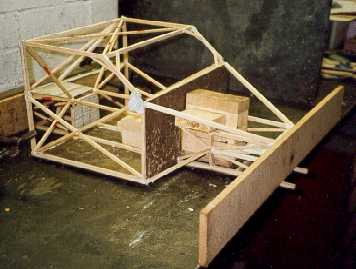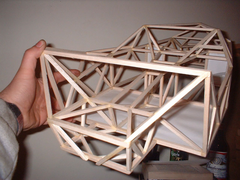I think my chassis is stiff enough for the job!!!!!


Hello,
Before start to build the chassis some of you draw the model and do some changes in it using AutoCAD or similar software.
Using that type of software is relatively simple to do a simulation to see the “limits” of the chassis and in witch part of the chassis it will be
most dangerous.
Some names of that kind of software are Ansys, Cosmos-SoliWorks and Pro.
So, I would to know if anyone use this kind of software- Finite Element Analysis?
Best Regards
Tiago
Yes, there is a member on here called Cymtriks that has performed FEA on the Locost chassis.
The results of his work can be found at http://locost7.info/files/chassis/kitcaranalysis_V2.doc
thanks for the info, i need to convert the units to the SI so i can understand all the results.
Don't know much about chassis software, but I do know that if you jack one wheel of my car up, 2 others lift up aswell.
I think my chassis is stiff enough for the job!!!!!
quote:
Originally posted by nitram38
Don't know much about chassis software, but I do know that if you jack one wheel of my car up, 2 others lift up aswell.
I think my chassis is stiff enough for the job!!!!!

My advice is a wooden model. Use 6mm wood available from B&Q and a glue gun.
It is quick and will tell you so much so easily. Twist it and bend it in your hands. I seem to have so much trouble convincing people of this method,
but then when they try they are stunned just how much they learnt. The main comment is along the lines of "Blxxxy hxxxl my chassis was
crap"
Then possibly use a computer. i used Grape (I think) to get some figures on my cage.

John
Our bible when building our car back in the late 90s was Alan Staniforth's Race and Rally Car Source Book.
There is much useful information and some invaluable tips in there. Among these, is to start with a balsa wood model chassis. This scales very well
against a steel frame and you can easily check your design for stiffness and clashes with mechanical components etc.
A really good book which Ican throroughly recommend. ISBN 0-85429-572-0
quote:
Originally posted by JB
My advice is a wooden model. Use 6mm wood available from B&Q and a glue gun.
It is quick and will tell you so much so easily. Twist it and bend it in your hands. I seem to have so much trouble convincing people of this method, but then when they try they are stunned just how much they learnt. The main comment is along the lines of "Blxxxy hxxxl my chassis was crap"
Then possibly use a computer. i used Grape (I think) to get some figures on my cage.

John
Staniforth uses balsawood for the model because the torsional stiffness of the model is directly scaleable to a fullsize steel spaceframe.
As an aside, Arthur Mallock who incidetally could not weld built his frame and then used a horizotal steel bar put through the frame and then twisted
to check for stiffness. The empirical method is always the best because there can be no inaccuracies or missed out factors.
John
I used balsa when I was playing around. Being able to grab the suspension mounts and twist taugth me than weeks of learning a s/w package ever would.
Use plastic card (from a model shop) to simulate welded in steel panels.
Got mine from hobbycraft, they do a bunch of sizes so you can scale build whatever you want (50x50, 25x25 etc) but any good model store should be able
to get some.
Oh yes, glue gun glue stays very hot for a while - found that out the hard way 
quote:
Originally posted by iank
Oh yes, glue gun glue stays very hot for a while - found that out the hard way
Another vote for the balsa wood method here. Amazing how you can feel the difference that a single added tube or paper panel can make!
Liam


Rescued attachment chasismodel.jpg
If you want to find out where the most highly stressed parts of the chassis are then I'd advise looking at making it stiffer first.
On nearly every analysis I've done a stiffer chassis has lower loads in most tubes for a given suspension load.
I can e-mail you a Nastran input deck if you want but it will be in imperial units.
Good Lord Liam... that's nearly large enough to put the engine in and go - no steel needed!
FEA isn't of any value unless you have enough engineering knowledge to know the correct type of elements and joints and exactly where to put the
restraints and loads.
Balsa model will tell a beginner far more.
[Edited on 9/7/06 by britishtrident]
quote:
Originally posted by cymtriks
If you want to find out where the most highly stressed parts of the chassis are then I'd advise looking at making it stiffer first.
On nearly every analysis I've done a stiffer chassis has lower loads in most tubes for a given suspension load.
I can e-mail you a Nastran input deck if you want but it will be in imperial units.